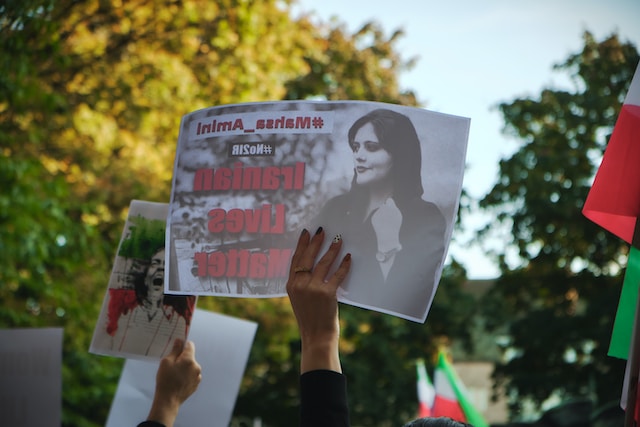Masha Amini’s shocking death by the moral police is revealed

[Artin Bakhan, Photo Credit to Unsplash]
Mahsa Amini was killed by the morality police of Iran while leaving a train station.
On September 16th, 2022, Mahsa Amini, a 22-year-old Iranian woman, was confronted by the morality police while leaving the train station with her family in Tehran.
Under the mission of "promoting virtue and avoiding vice," the morality police soon arrested her for breaking Iran's traditional dress code.
Only a few hair strands were peeking out of her Hijab.
After her brother heard about Mahsa Amini's arrest, he ran to the morality police detention facility.
He discovered that his sister had been brutally assaulted by the police and was carried to the hospital.
However, when the brother rushed to see his sister in the hospital, Mahsa Amini had already lost her ability to breathe (Makoii, CNN).
The tragic event of Mahsa Amini's death stems from the highly contentious "Hijab Law" in Iran.
The Hijab Law was first introduced in 1979, and mandates Iranian women to wear head coverings in public spaces.
This law is a part of the government's strict dress code policies, where women who do not comply with the regulations are subjected to harassment and punishment by the morality police (Talei, CEFIP).
Though initially it was primarily the morality police that was in charge of enforcing the regulation, the Hijab Law became fixed as a legal measure, and those who did not abide by it were punishable by criminal law.
The punishments for not obeying the Hijab Law varies from simple fines to imprisonment.
However, many suffer from the fatal assaults of the morality police, which often result in hospitalizations and even heart attacks and deaths.
On the surface, the enforcement of Hijab requirements is carried out for religious reasons.
Some governments that force Hijab-related regulations state that many Muslims regard the Hijab as a religious necessity.
In contrast, others argue that it is required to preserve modesty and dignity among women.
In many Muslim nations, wearing the Hijab is considered a cultural custom and a statement of religious devotion and national identity (United Against Nuclear Iran).
Iran’s new president, Ebrahim Raisi, promised the intensification of the Islamization of the society.
However, this statement contradicts his hijab policy, as Islam does not FORCE the hijabs. Others further claim that the headscarf is a means of rejecting Westernization and preserving traditional cultural customs.
Although Iran initially enjoyed relative freedom and acceptance of foreign culture, the Iranian government became strict and adamant about discarding all western influences since the Islamic revolution of 1979.
Mahsa Amini's death sparked a nationwide protest and motivated Iranian citizens, as young as high school students, to protest against the mandatory Hijab.
As a result, many more women were sacrificed and fell victim to police brutality and the Iranian government’s abuse of power .
Nika Shakarami, a sixteen-year-old teenager participating in one of these protests, suddenly disappeared during the demonstration.
A video of her burning the Hijab in front of protesters surfaced on social media, and the government acted swiftly by detaining her.
She was reported missing for the first ten days.
However, after her family gained access to surveillance cameras nearby, they discovered their beloved daughter slaughtered by the police (Polglase, CNN).
While the family members were enraged and asked for clarifications, the morality police and the government merely stated that she had died under suspicious circumstances.
The deaths of these girls are only a part of the countless violence that women who object to mandatory Hijab regulations have to face.
The mandatory Hijab law is not merely a dress code law, it also takes away women's control of their bodies in public.
The hijab law limits everyday life in Iran and forces segregation of the sexes, and also promotes censorship as women are not allowed to appear without a hijab on TV or in movies.
According to Iran International, the Islamic Republic has banned the usage of female images or actors in every type of Iranian commercial and advertisement because of the Hijab law.
The Iranian women's protest is not a movement to reject the Hijab itself but a fight for the fundamental right that the government should not take away individual freedom.
Under the pretense of preserving customs and keeping order, the Iranian government gains more authority by forcing women to wear Hijabs.
The government pressures families, communities, and religious leaders to enforce Hijab requirements, thereby stigmatizing women who do not wear Hijabs as social outcasts.
Through these arbitrary regulations, the government can wield more significant influence over people's lives and create a social order that satiates its interests.
Moreover, by mandating Hijabs, the government strengthens its control over women's lives.
It produces a society more aligned with its ideals and views with no regard for the fundamental human rights of its citizens.
There are several reasons that the Hijab Law is oppressive and abusive to women.
First, as women are compelled to wear Hijabs at all times in public, it restricts their general mobility and ability to engage in activities such as sports or driving.
Second, Hijab limits women's freedom of expression, restricting the freedom to express themselves through their hairstyle and clothes.
Third, it erases all uniqueness and forces women to blend into a uniform mass.
Wearing the Hijab could also restrict women from connecting with others, resulting in feelings of social isolation and loneliness.
Furthermore, and most significantly, there is added scrutiny and inspection against women because they are constantly checked and monitored by the state, often being stopped and unnecessarily searched by authorities.
In other words, the Hijab regulations promote gender discrimination and misogyny, as well as censorship and the restriction of fundamental human rights.
Mahsa Amini’s death is an accumulation of all the sociopolitical, ethnic, religious, and gender grievances that Iranian women have faced.
Her Kurdish ethnicity also affected her brutal punishment and death because the Kurdish people are discriminated against by the Iranian government, as they are ironically not regarded as the same people while being denied independent statehood.
In addition, her religious beliefs as Sunni muslim, a minority islamic belief in Iran, further contributed to her discrimination.
Gender acts as a tool of oppression in Iran because women in Iran have been discriminated against for a long time, leading to limitations on human rights and harassment from men.

- Ryan Oh / Grade 9
- Chadwick International School

![THE HERALD STUDENT REPORTERS [US]](/assets/images/logo_student_us.png)
![THE HERALD STUDENT REPORTERS [Canada]](/assets/images/logo_student_ca.png)
